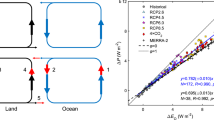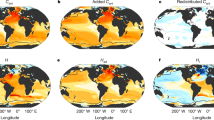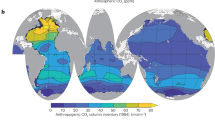Abstract
The carbon cycle has a central role in climate change. For example, during glacial–interglacial cycles, atmospheric carbon dioxide has altered radiative forcing and amplified temperature changes. However, it is unclear how sensitive the climate system has been to changes in carbon cycling in previous geological periods, or how this sensitivity may evolve in the future, following massive anthropogenic emissions. Here we develop an analytical relationship that links the variation of radiative forcing from changes in carbon dioxide concentrations with changes in air–sea carbon cycling on a millennial timescale. We find that this relationship is affected by the ocean storage of carbon and its chemical partitioning in sea water. Our analysis reveals that the radiative forcing of climate is more sensitive to carbon perturbations now than it has been over much of the preceding 400 million years. This high sensitivity is likely to persist into the future as the oceans become more acidic and the bulk of the fossil-fuels inventory is transferred to the ocean and atmosphere.
This is a preview of subscription content, access via your institution
Access options
Subscribe to this journal
Receive 12 print issues and online access
$259.00 per year
only $21.58 per issue
Buy this article
- Purchase on Springer Link
- Instant access to full article PDF
Prices may be subject to local taxes which are calculated during checkout





Similar content being viewed by others
References
IPCC 2007. Climate Change 2007: The Physical Science Basis. Contribution of Working Group I to the Fourth Assessment Report of the Intergovernmental Panel on Climate Change (Cambridge Univ. Press, 2007).
Petit, J. R. et al. Climate and atmospheric history of the past 420,000 years from the Vostok ice core, Antarctica. Nature 399, 429–436 (1999).
Siegenthaler, U. et al. Stable carbon cycle-climate relationship during the late Pleistocene. Science 310, 1313–1317 (2005).
Myhre, G., Highwood, E. J., Shine, K. P. & Stordal, F. New estimates of radiative forcing due to well mixed greenhouse gases. Geophys. Res. Lett. 25, 2715–2718 (1998).
Bolin, B. & Eriksson, E. in The Atmosphere and the Sea in Motion: Scientific Contributions to the Rossby Memorial Volume (ed. Bolin, B.) 130–142 (Rockefeller Inst. Press, 1959).
The Royal Society. Ocean Acidification Due to Increasing Atmospheric Carbon Dioxide, Policy document 12/05, ISBN 0 85403 617 2 (The Royal Society, 2005); available at <http://www.royalsoc.ac.uk>.
Ridgwell, A. & Zeebe, R. E. The role of the global carbonate cycle in the regulation and evolution of the Earth system. Earth Planet. Sci. Lett. 234, 299–315 (2005).
Ridgwell, A. A Mid Mesozoic revolution in the regulation of ocean chemistry. Mar. Geol. 217, 339–357 (2005).
Ridgwell, A. Interpreting transient carbonate compensation depth changes by marine sediment core modeling. Paleoceanography 22, PA4102 (2007).
Berner, R. A. A model for atmospheric CO2 over Phanerozoic time. Am. J. Sci. 291, 339–376 (1991).
Berner, R. A. & Kothavala, Z. GEOCARB III: A revised model of atmospheric CO2 over Phanerozoic time. Am. J. Sci. 301, 182–204 (2001).
Joos, F., Plattner, G-K, Stocker, T. F., Marchal, O. & Schmittner, A. Global warming and marine carbon cycle feedbacks on future atmospheric CO2 . Science 284, 464–467 (1999).
Friedlingstein, P. et al. Climate carbon cycle feedback analysis: Results from the C4MIP model intercomparison. J. Clim. 19, 3337–3353 (2006).
Lenton, T. M. et al. Millennial timescale carbon cycle and climate change in an efficient Earth system model. Clim. Dyn. 26, 687–711 (2006).
Lenton, T. M. Land and ocean carbon cycle feedback effects on global warming in a simple Earth system model. Tellus 52B, 1159–1188 (2000).
Archer, D. The fate of fossil fuel in geologic time. J. Geophys. Res. 110, C09S05 (2005).
Archer, D., Kheshgi, H. & Maier-Reimer, E. Multiple timescales for neutralization of fossil fuel CO2 . Geophys. Res. Lett. 24, 405–408 (1997).
Goodwin, P., Williams, R. G., Follows, M. J. & Dutkiewicz, S. Ocean-atmosphere partitioning of anthropogenic carbon dioxide on centennial timescales. Glob. Biogeochem. Cycles 21, GB1014 (2007).
Goodwin, P., Follows, M. J. & Williams, R. G. Analytical relationships between atmospheric carbon dioxide, carbon emissions, and ocean processes. Glob. Biogeochem. Cycles 22, GB3030 (2008).
Sabine, C. L. et al. The oceanic sink for anthropogenic CO2 . Science 305, 367–371 (2004).
Ridgwell, A. et al. Marine geochemical data assimilation in an efficient Earth System Model of global biogeochemical cycling. Biogeosciences 4, 87–104 (2007).
Sigman, D. M. & Boyle, E. A. Glacial/interglacial variations in atmospheric carbon dioxide. Nature 407, 859–869 (2000).
Rogner, H. H. An assessment of world hydrocarbon resources. Annu. Rev. Energy Environ. 22, 217–262 (1997).
Royer, D. L., Berner, R. A., Montanez, I. P., Tabor, N. J. & Beerling, D. J. CO2 as a primary driver of Phanerozoic climate. GSA Today 14, 4–10 (2004).
Pagani, M., Caldeira, K., Archer, D. & Zachos, J. C. An ancient carbon mystery. Science 314, 1556–1557 (2006).
Panchuk, K., Ridgwell, A. & Kump, L. R. Sedimentary response to Paleocene-Eocene Thermal Maximum carbon release: A model-data comparison. Geology 36, 315–318 (2008).
Kennett, J. P. & Stott, L. D. Abrupt deepsea warming palaeoceanographic changes and benthic extinctions at the end of the Paleocene. Nature 353, 225–229 (1991).
Röhl, U., Bralower, T. J., Norris, R. D. & Wefer, G. New chronology for the late Paleocene thermal maximum and its environmental implications. Geology 28, 927–930 (2000).
Held, I. The gap between simulation and understanding in climate models. Bull. Am. Meteorol. Soc. 1609–1614 (2005).
Brewer, P. G. Direct observation of the oceanic CO2 increase. Geophys. Res. Lett. 5, 997–1000 (1978).
Ito, T. & Follows, M. J. Preformed phosphate soft tissue pump and atmospheric CO2 . J. Mar. Res. 63, 813–839 (2005).
Sarmiento, J. L. & Toggweiler, J. R. A new model for the role of the oceans in determining atmospheric P CO 2 . Nature 308, 621–624 (1984).
Acknowledgements
This research was supported by NERC grants NE/F002408/1 and NE/F001657/1.
Author information
Authors and Affiliations
Contributions
P.G., R.G.W. and M.J.F. contributed theory to the study and A.R. conducted the supporting numerical modelling with GENIE-1. P.G. and R.G.W. led the writing of this study, and contributed equally, together with inputs from A.R. and M.J.F.
Corresponding authors
Supplementary information
Supplementary Information
Supplementary Information (PDF 398 kb)
Rights and permissions
About this article
Cite this article
Goodwin, P., Williams, R., Ridgwell, A. et al. Climate sensitivity to the carbon cycle modulated by past and future changes in ocean chemistry. Nature Geosci 2, 145–150 (2009). https://doi.org/10.1038/ngeo416
Received:
Accepted:
Published:
Issue Date:
DOI: https://doi.org/10.1038/ngeo416
This article is cited by
-
Enhanced weathering strategies for stabilizing climate and averting ocean acidification
Nature Climate Change (2016)
-
How historic simulation–observation discrepancy affects future warming projections in a very large model ensemble
Climate Dynamics (2016)
-
Sensitivity of climate to cumulative carbon emissions due to compensation of ocean heat and carbon uptake
Nature Geoscience (2015)
-
Circumspection, reciprocity, and optimal carbon prices
Climatic Change (2013)
-
Climate Change and Sea-Level Rise: Impact On Agriculture Along Andhra Pradesh Coast—A Geomatics Analysis
Journal of the Indian Society of Remote Sensing (2011)



